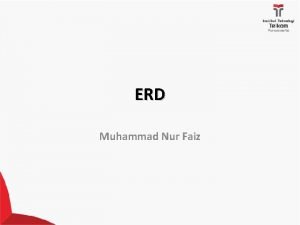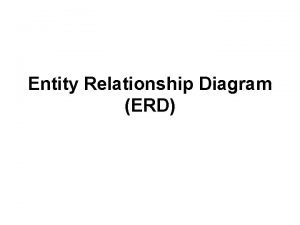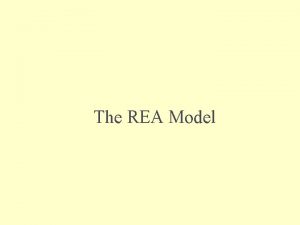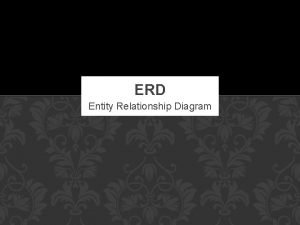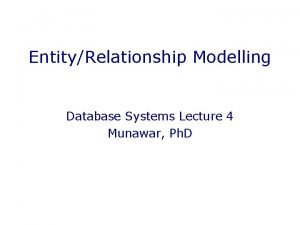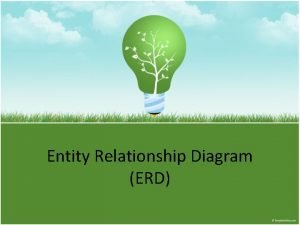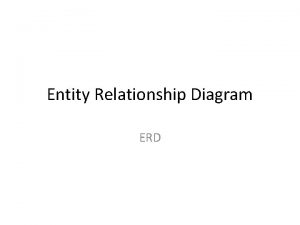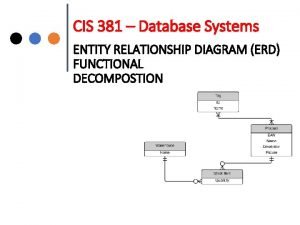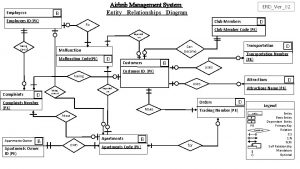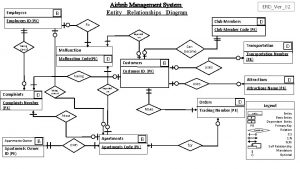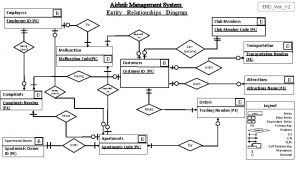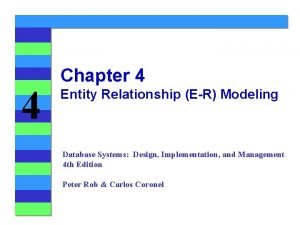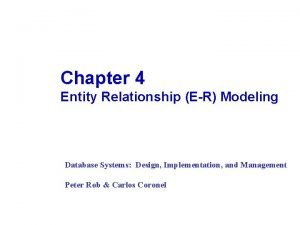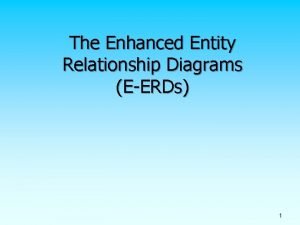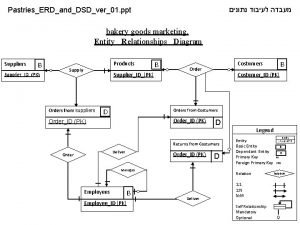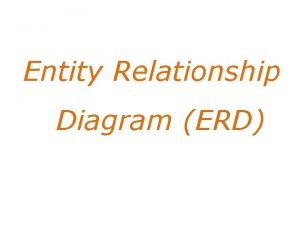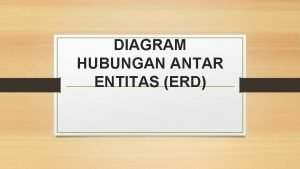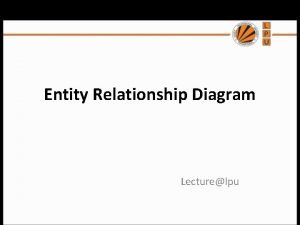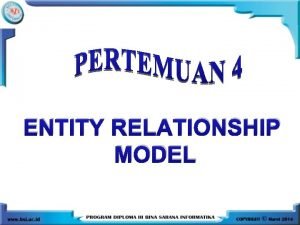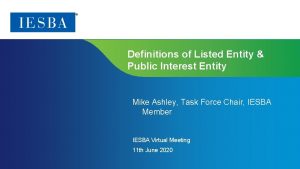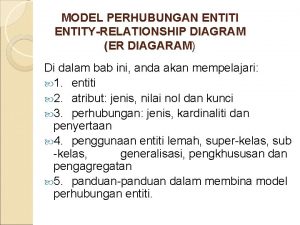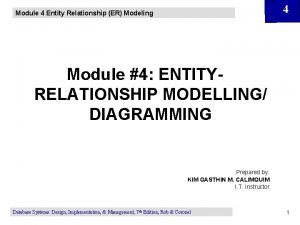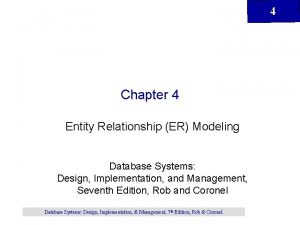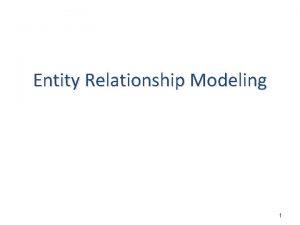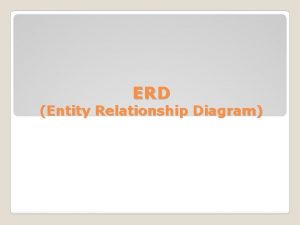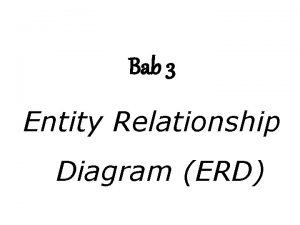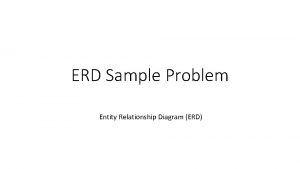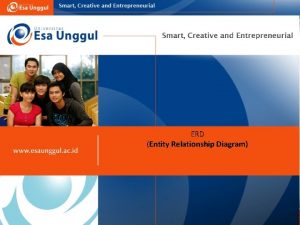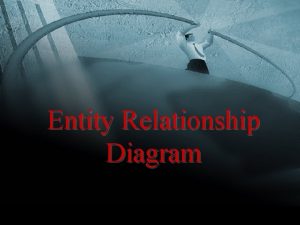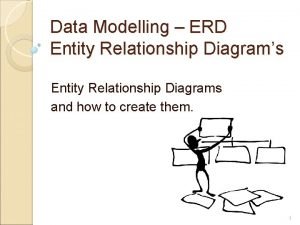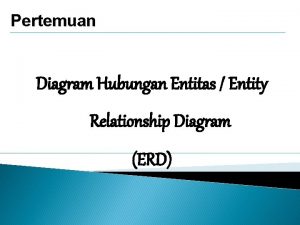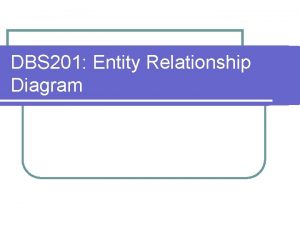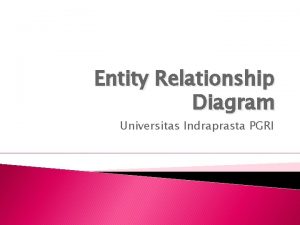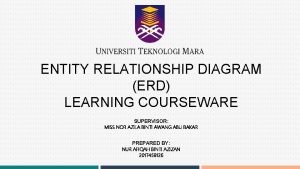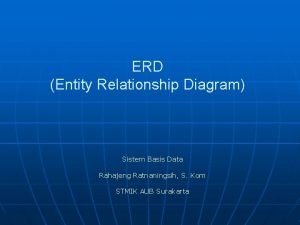Lecture 3 Entity Relationship diagram ERD Cardinalities Converting































- Slides: 31

Lecture 3 • Entity Relationship diagram (ERD) • Cardinalities • Converting ERD into tables (relations) • An ERD example • Q 8/p 139 INSS 651 1

Entities An object of interest • Person • Place • Event • Concept Ex: Student Order Customer INSS 651 2

Super & Sub Type Entities Recognize common theme WORKER (SUPER TYPE) • PART TIME (SUB TYPE) • FULL TIME (SUB TYPE) • CONTRACTUAL (SUB TYPE) INSS 651 3

Relationship • “Has A” between entities TEAM PLAYER • “IS A” between super & sub entities WORKER PART TIME FULL TIME INSS 651 4

INHERITANCE • Sub type entities inherit all attributes & procedures of its SUPER entity type • Also the basis of Objects INSS 651 5

Attributes • Properties of an entity • Describes an entity Ex: attribute of an entity STUDENT student name student address etc INSS 651 6

Domain Set of allowable values for an attribute Ex: Student_age (between 15 -85) Student _classification (Graduate or Undergraduate) INSS 651 7

Relationship Exists between entities Recursive. . within itself Binary between TWO entities Ternary between THREE entities INSS 651 8

Nature of Relationship between ENTITIES • 1: 1 (one is to one) • 1: m (one to many) • m: n (many to many) INSS 651 9

Recursive An entity has relationship to itself, it could be 1: 1; 1: m or m: n EX: EMPLOYEES MARRIED TO OTHER EMPLOYEES EMPLOYEE INSS 651 10

CREATE A TABLE WITH EMP_SPOUSE NUMBER ADDED TO IT EMPLOYEE (EMP_NO, EMP_NAME, …, SPOUSE_NO) INSS 651 11

Cardinalities Relates specific occurrences of ONE entity to other, and vice-versa STUDENT COURSE MIN cardinality MAX cardinality INSS 651 12

Min, Max STUDENT < ------- >CLASS What’s the minimum number of classes a student can take zero, what’s the max, say 6 What’s the minimum number of students a class can have say 1, max say 40 (class limit), then STUDENT< ------- >CLASS (0, 6) (1, 40) INSS 651 13

Another Cardinality Example Patient Pat_history What’s the minimum number of patient history a patient can have? 1 What’s the maximum ? Many, say N What’s the minimum number of patient a patient history can belong to? Maximum? INSS 651 14

Patient (1, N) Pat_history (1, 1) INSS 651 15

Converting 1: 1; 1: m and m: n into relations 1: 1 Each entity becomes a relation and PK of either entity becomes a FK in the other entity ASSUME AN EMPLOYEE CAN have only one car and a car belongs to only ONE employee EMPLOYEE CAR Relations: EMPLOYEE (emp_no, emp_name, . . , car_id) CAR (car_id, model, make…) Note: or emp_no could be FK in CAR INSS 651 16

1: m • PK of PARENT becomes FK in the CHILD Ex: Assume: A team can have many players and a player can play for ONLY ONE team TEAM PLAYER TEAM (Team_name, location, manager, . . ) PLAYER (Player_name, …Team_Name) INSS 651 17

M: N • Convert m: n into TWO 1: m by introducing an intersection entity • The intersection contains PK of both entities CLASS STUDENT GRADE STUDENT CLASS (class_id, # of students, . . ) STUDENT (st_id, st_name, GPA, . . ) GRADE (class_id, st_id, semester, grade, . . ) INSS 651 18

EX: Convert following ERD into relations assume a student can be advised by one professor but a professor can advise many students, a club can have many students but a student can join only one club, then the ERD will look as STUDENT PROFESSOR CLUB INSS 651 19

Relations will be STUDENT (St_ID, st_name, …, Club_ID, Prof_ID) Note: we must account for both relationships in STUDENT entity (student, professor) AND (student, club) CLUB (Club_ID, location, date_established, . . ) PROFESSOR (Prof_ID, Prof_name, specialty, . . ) INSS 651 20

Building an ER model Q 8/P 139 Identify entities DINNER ENTRÉE GUEST INSS 651 21

Relationships • Each dinner is based on a single entrée, but each entrée can be served at many dinners ENTREE DINNER INSS 651 22

Cardinality One entrée can be part of a min of 1 dinner and a max of many dinners, say n One dinner can be part of a minimum of one entrée and a max of one entrée entree (1, N) dinner (1, 1) INSS 651 23

Relationship between DINNER and GUEST Note there are TWO relationships A guest can attend many dinners Vice versa A guest can have many dinner invitations Vice versa invitation Dinner Guest INSS 651 24

Relationship between DINNER and GUEST Note there are TWO relationships A guest can attend many dinners Vice versa Dinner Guest Attend INSS 651 25

Relationship between DINNER and GUEST Second relationship A guest can have many dinner invitations Vice versa Dinner invitation Guest INSS 651 26

Converting m: n into two 1: m since Guest and DINNER is m: n we can break into TWO 1: m i. e ATTEND entity is intersection of DINNER & GUEST DINNER ATTEND INSS 651 GUEST 27

cardinality What is ATTEND entity ? a combination of a dinner and a guest • What’s the min number of DINNER in ATTEND? 1 • (a dinner must be part of at lest ONE function (ATTEND) Max number? N (assuming N is total # of dinners) An attend can be part as a min part of one dinner and a max of ONE dinner also • what’s the min number of ATTEND a GUEST can have? 0 • (a guest may not attend any dinner) or they may attend a max of N dinners DINNER (1, N) ATTEND (1, 1) INSS 651 GUEST (0, N) 28

• Same concepts can be applied to INVITATION intersection entity INSS 651 29

ERD Q 8/p 139 INSS 651 30

INSS 651 31
 Contoh er diagram
Contoh er diagram Entity-relationship diagram (erd) merupakan
Entity-relationship diagram (erd) merupakan Expenditure cycle rea diagram
Expenditure cycle rea diagram Rea diagram cardinalities
Rea diagram cardinalities Pengertian entity relationship diagram
Pengertian entity relationship diagram Student course entity relationship diagram
Student course entity relationship diagram Elements of entity relationship diagram
Elements of entity relationship diagram Simbol pada erd
Simbol pada erd Peter chen er diagram
Peter chen er diagram Erd business rules examples
Erd business rules examples Airbnb er diagram
Airbnb er diagram Airbnb erd
Airbnb erd Airbnb erd
Airbnb erd College entity relationship diagram
College entity relationship diagram Entity occurrence diagram
Entity occurrence diagram Airbnb erd
Airbnb erd Partial specialization rule
Partial specialization rule Bakery marketing plan powerpoint
Bakery marketing plan powerpoint Penjelasan erd
Penjelasan erd Diagram hubungan antar entitas
Diagram hubungan antar entitas Entity relationship diagram video rental store
Entity relationship diagram video rental store Erd adalah
Erd adalah Contoh eer
Contoh eer Recursive relationships are expressed on the erd with:
Recursive relationships are expressed on the erd with: Contoh yang menunjukkan mengenai participant constraint
Contoh yang menunjukkan mengenai participant constraint Contoh weak entity
Contoh weak entity Public interest entity vs listed entity
Public interest entity vs listed entity Public interest entity
Public interest entity Perkaitan alat diagram
Perkaitan alat diagram Bridge entity erd
Bridge entity erd Tiny college erd
Tiny college erd Bridge entity erd
Bridge entity erd
